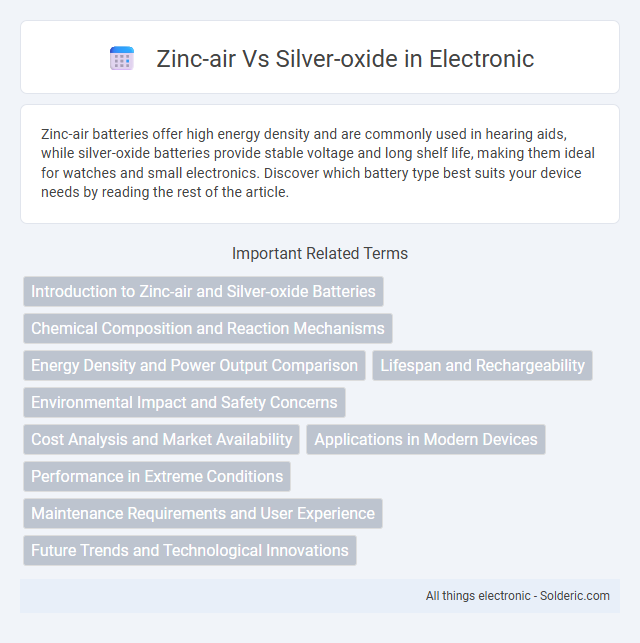Zinc-air batteries offer high energy density and are commonly used in hearing aids, while silver-oxide batteries provide stable voltage and long shelf life, making them ideal for watches and small electronics. Discover which battery type best suits your device needs by reading the rest of the article.
Comparison Table
| Feature | Zinc-Air | Silver-Oxide |
|---|---|---|
| Energy Density | High (up to 300 mAh/g) | Moderate (around 130-150 mAh/g) |
| Voltage | 1.4 V nominal | 1.55 V nominal |
| Common Applications | Hearing aids, medical devices | Watches, calculators, small electronics |
| Shelf Life | 3-5 years (sealed) | 3-5 years |
| Cost | Lower | Higher |
| Environmental Impact | Relatively eco-friendly (uses zinc) | Contains silver; more costly to recycle |
| Discharge Characteristics | Stable voltage until near depletion | Stable voltage, slightly higher capacity fade |
Introduction to Zinc-air and Silver-oxide Batteries
Zinc-air batteries utilize oxygen from the air as a cathode reactant, offering high energy density and lightweight design, making them ideal for hearing aids and medical devices. Silver-oxide batteries feature a silver oxide cathode and zinc anode, providing stable voltage output and reliable performance in compact electronics like watches and calculators. Both battery types deliver long shelf life and consistent power but differ significantly in chemistry and application suitability.
Chemical Composition and Reaction Mechanisms
Zinc-air batteries utilize zinc metal as the anode and oxygen from the air as the cathode reactant, engaging in an electrochemical reaction where zinc oxidizes and oxygen is reduced to form zinc hydroxide. Silver-oxide batteries contain a silver(I) oxide cathode and a zinc anode, with the reaction involving the reduction of silver oxide to metallic silver and the oxidation of zinc to zinc oxide. The zinc-air system relies on atmospheric oxygen diffusion through a porous cathode, resulting in high energy density, while silver-oxide batteries have sealed systems with stable voltage output due to the solid-state silver oxide reactant.
Energy Density and Power Output Comparison
Zinc-air batteries offer a superior energy density of approximately 300-400 Wh/kg, significantly higher than silver-oxide batteries, which typically provide around 130-170 Wh/kg. Silver-oxide batteries, however, deliver higher power output with stable voltage and reliable current, making them ideal for applications requiring consistent bursts of power such as hearing aids. The trade-off between zinc-air's extended energy capacity and silver-oxide's enhanced power delivery influences their selection based on device power demands and operational duration.
Lifespan and Rechargeability
Zinc-air batteries typically offer a longer lifespan due to their high energy density and are widely used in hearing aids, but they are non-rechargeable and must be replaced once depleted. Silver-oxide batteries provide stable voltage and reliable performance with a moderate lifespan, commonly powering small electronics like watches, and some variants are available in rechargeable forms. Your choice depends on whether you prioritize extended battery life or the convenience of rechargeability for your device.
Environmental Impact and Safety Concerns
Zinc-air batteries offer a more environmentally friendly option due to their use of abundant zinc and non-toxic air cathodes, resulting in lower heavy metal pollution compared to silver-oxide batteries, which contain silver and can pose disposal challenges. Safety concerns with silver-oxide batteries include potential leakage of toxic electrolytes and higher cost-related environmental strain during mining and refining of silver. You can reduce ecological risks by choosing zinc-air cells, which provide safer disposal and recycling options.
Cost Analysis and Market Availability
Zinc-air batteries offer a cost-effective solution due to their lower raw material expenses and widespread manufacturing, making them more affordable and readily available in the market compared to silver-oxide batteries. Silver-oxide batteries, while providing higher energy density and better performance, come at a premium price because of the expensive silver content and limited production scale. Your choice between these two battery types will depend on balancing budget constraints with performance needs, considering zinc-air for cost-efficiency and silver-oxide for specialized applications.
Applications in Modern Devices
Zinc-air batteries dominate hearing aids and large-scale energy storage due to their high energy density and eco-friendly nature, while silver-oxide batteries excel in small electronic devices like wristwatches and medical implants because of their stable voltage and compact size. Zinc-air technology is increasingly used in electric vehicle prototypes, leveraging its lightweight and cost-effective materials. Silver-oxide cells remain preferred in precision instruments requiring reliable, long-lasting power despite their higher cost and lower capacity compared to zinc-air counterparts.
Performance in Extreme Conditions
Zinc-air batteries excel in extreme conditions due to their high energy density and ability to operate efficiently in low temperatures, making them ideal for hearing aids and medical devices. Silver-oxide batteries provide superior stable voltage output and performance in high-drain applications under varying temperatures, ensuring reliability in watches and cameras. Your choice should consider zinc-air's lightweight and cost-efficiency versus silver-oxide's consistent power delivery in fluctuating environments.
Maintenance Requirements and User Experience
Zinc-air batteries require minimal maintenance due to their activation upon exposure to air, offering a lightweight and long-lasting power source ideal for hearing aids and small devices. Silver-oxide batteries provide stable voltage and high energy density but may need regular replacement due to faster discharge rates, affecting user convenience. Both battery types deliver reliable performance, yet zinc-air's ease of use and extended life enhance overall user satisfaction.
Future Trends and Technological Innovations
Zinc-air batteries are advancing with improved oxygen cathode catalysts and enhanced electrolyte stability, driving higher energy density and extended cycle life for wearable electronics and hearing aids. Silver-oxide batteries benefit from miniaturization and flexible form factors, integrating nanoscale silver particles to boost conductivity and energy efficiency in medical implants and military applications. Emerging hybrid systems combining zinc-air and silver-oxide technologies aim to optimize power output and durability, positioning these batteries at the forefront of next-generation energy storage solutions.
Zinc-air vs Silver-oxide Infographic

 solderic.com
solderic.com